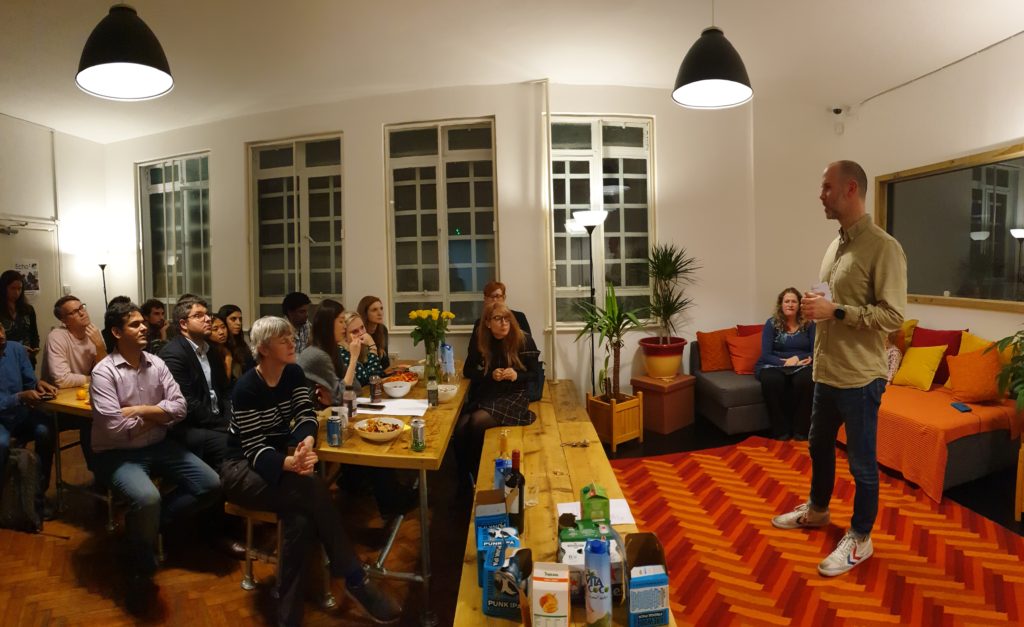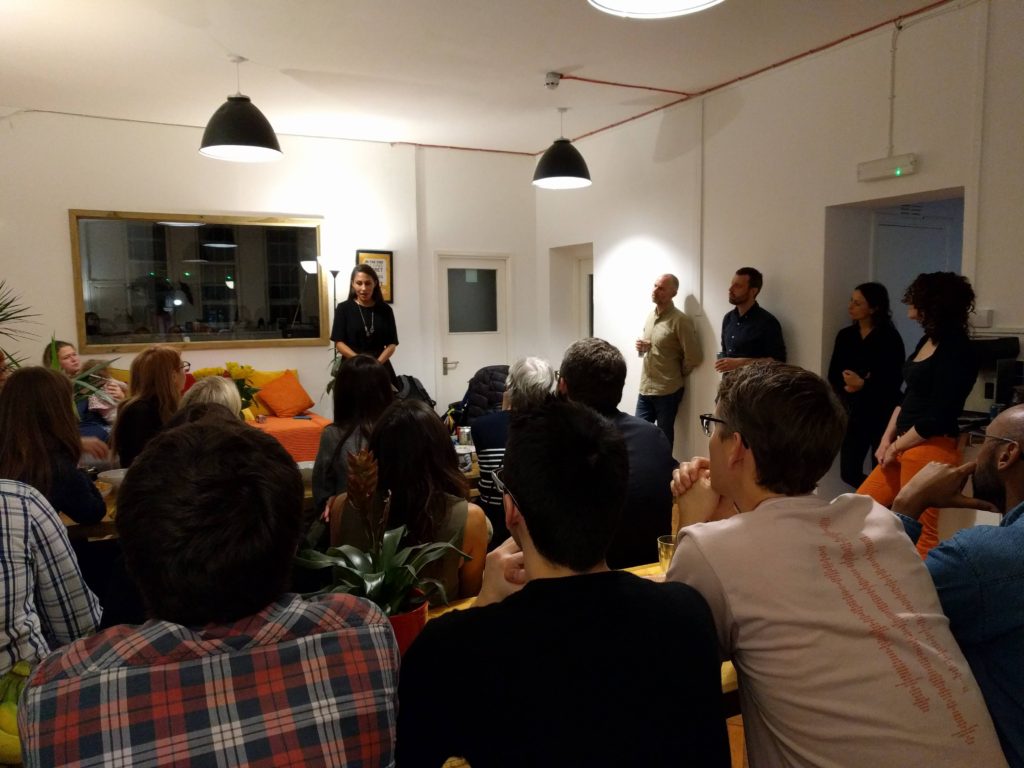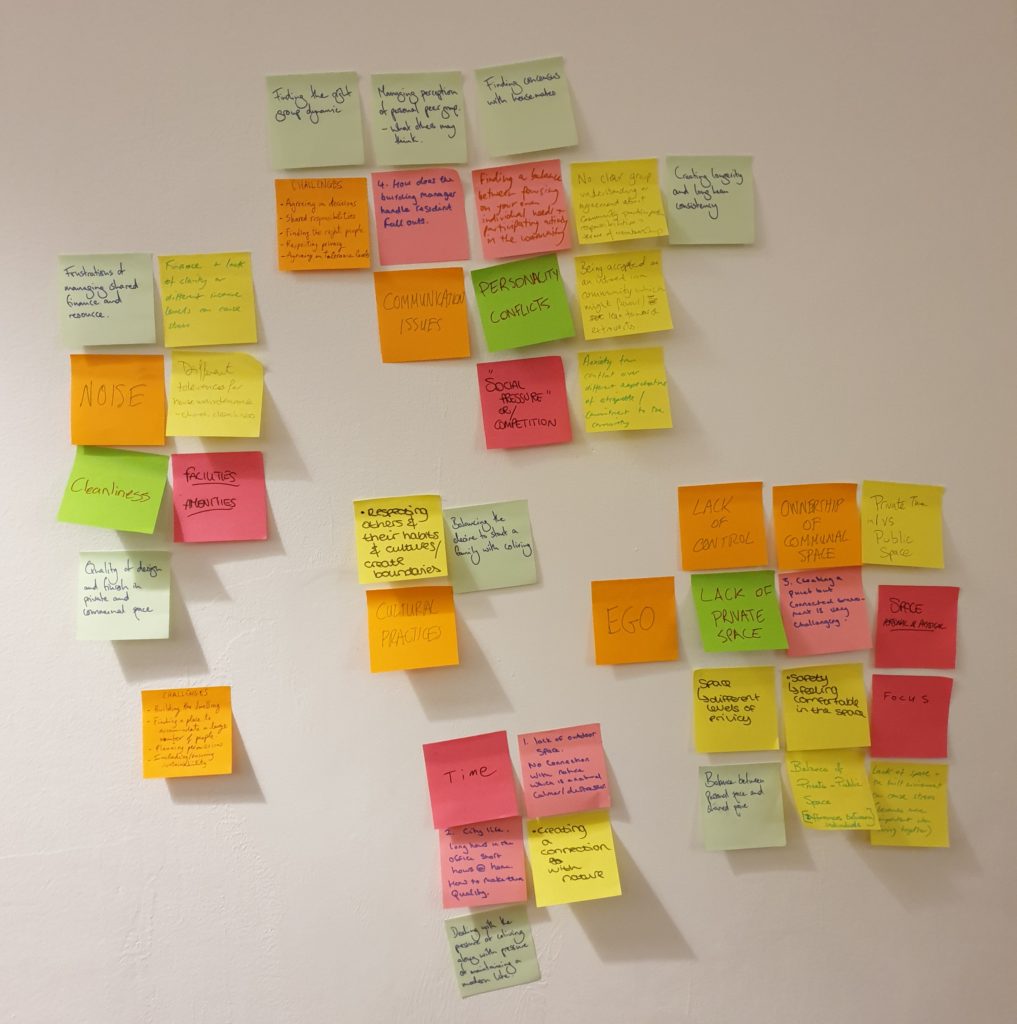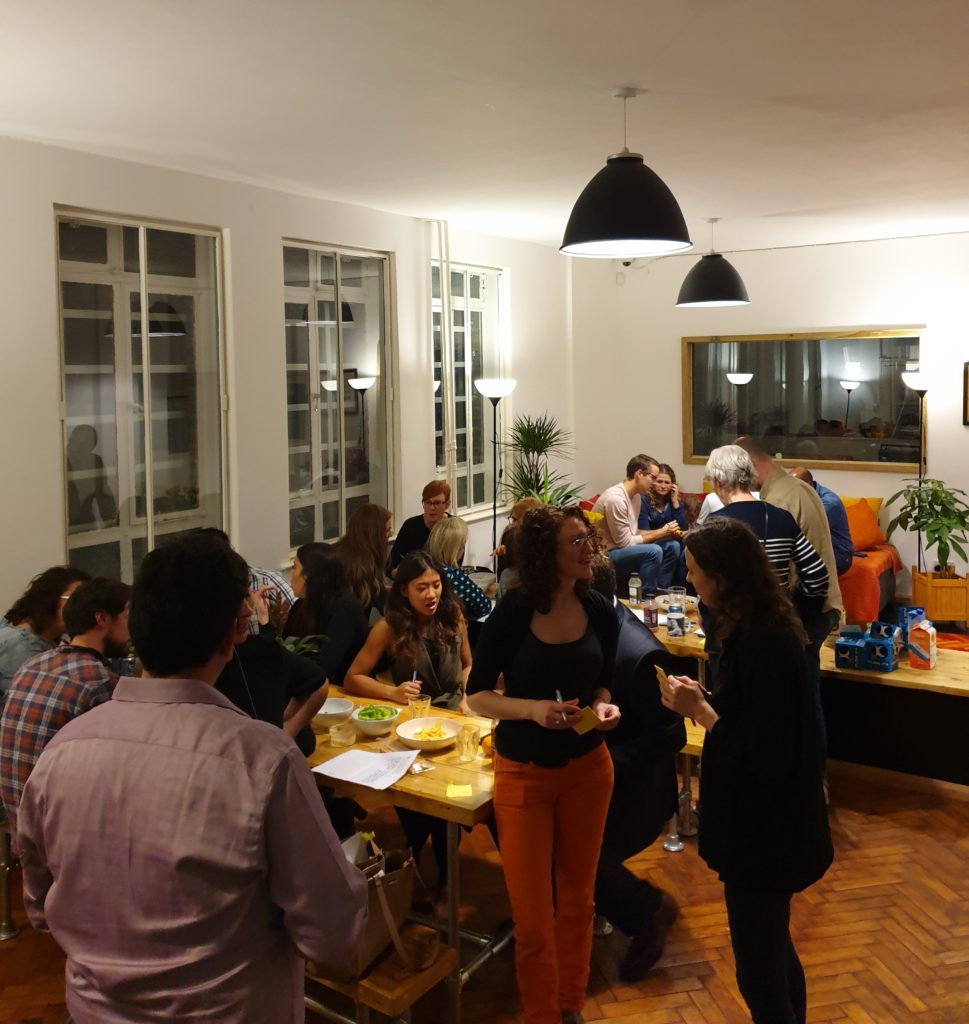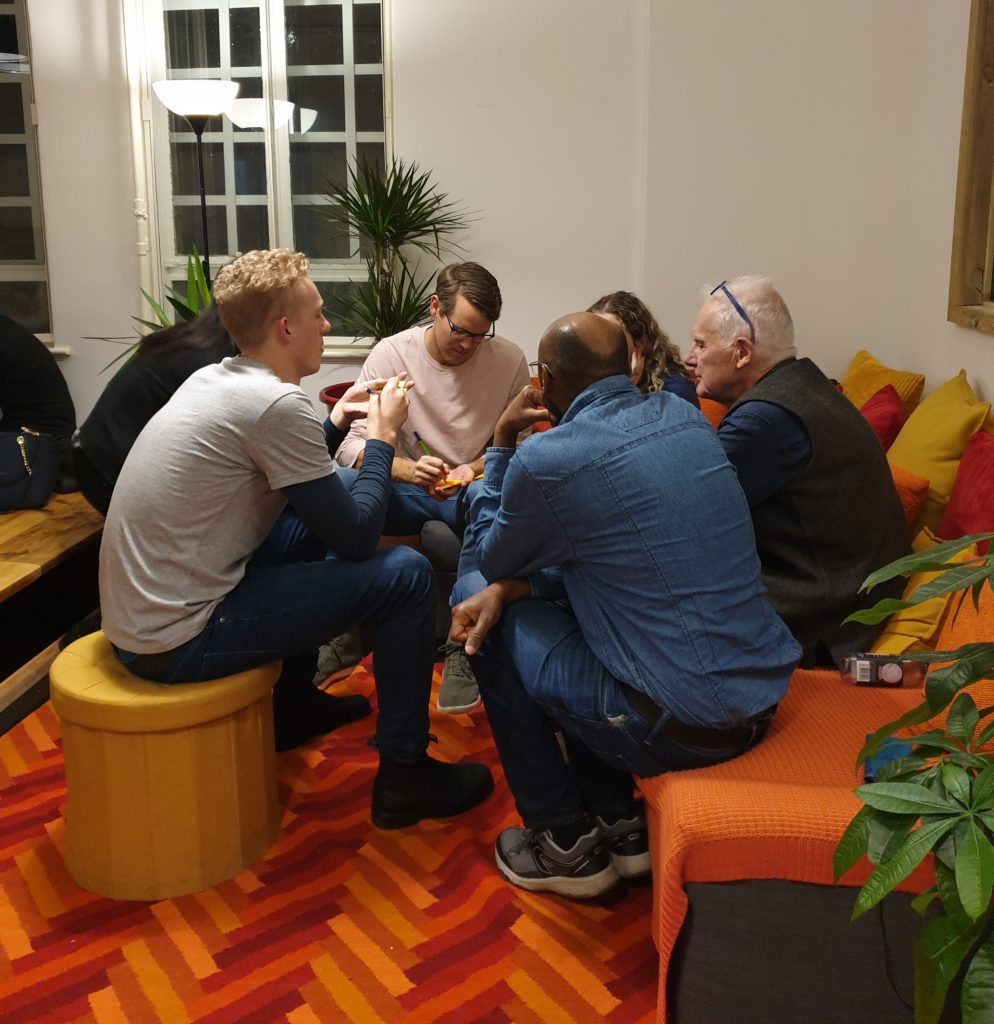Coliving is frequently sold as a lifestyle in which wellbeing is part of the service, with yoga classes, clean eating and stress-free plug-in-and-play living seen as par for the course. However, what challenges does coliving raise in terms of providing a sense of wellbeing for its residents, and what strategies can operators use to create an environment that truly fosters healthy and contented residents?
This was the topic of our second Coliving London Meetup, which was co-hosted by Conscious Coliving (coliving consultants) and Co-Liv, and sponsored by SALTO Systems / SALTO KS and Mainyard Studios.
We were joined by a diverse group, including property developers and investors, coliving and HMO operators, architects, consultants, specialist software providers, and cohousing and coliving residents and enthusiasts, for what proved to be a highly informative evening.
Keynote speakers
The evening began with talks from our two keynote speakers.
Our first speaker was Leigh Chapman, founder of the Yinshi Pod, which is designed to enable meditation in shared spaces. After giving us a potted history of the origins of meditation, and an overview of its benefits, Leigh told us about his own journey into meditation, and how the concept of the Yinshi Pod was born as a result of his struggles to find somewhere to meditate in his workplace (the toilet being the best place at the time!).
Trials have shown that as well as being a practical tool to enable meditation, the Pods are an important physical signifier of the intention to prioritise mental wellbeing. You can read more about Leigh’s story here.
Our second speaker was Natasha Reid, architect and Director of Natasha Reid Design, a practice that specialises in creating spaces which foster wellbeing. You can see some of her projects here. Natasha spoke about a framework she has developed which effectively conceptualises three different aspects of wellbeing.
The first level to consider is emotional wellbeing, the second, social wellbeing, and the third is the wellbeing which arises from a sense of connection and belonging in a place. Natasha described how within each level there are a myriad of design considerations which can enable greater wellbeing. Learning about Natasha’s framework was a brilliant way to get everybody thinking about the many different types of wellbeing to consider in relation to coliving.
Both Natasha and Leigh provided great starting points for the workshop which followed.
The workshop
Workshop attendees were asked to brainstorm the challenges relating to wellbeing in coliving spaces. We then grouped these challenges into the following categories:
- The challenges of time scarcity and pressures of urban living
- The balance between public and private space
- Practical elements e.g. noise, cleanliness
- Personal conflicts
People then split into groups and discussed what strategies they would use to deal with these different issues. We then came together to share our insights and further discuss each topic.
Below are our key insights and takeaways.
1.The challenges of time scarcity and pressures of urban living
- Provide a variety of spaces which allow people to enjoy whatever their version of quality time is e.g. think about having social spaces, quiet spaces, semi-private or private spaces; spaces which allow access to nature through water or greenery.
- Encourage quality time, not just relaxation. What does “quality” time mean? Time spent that is satisfying or nourishing in some way. Think about having hobby groups: encourage activities such as conversation, crafts, games, meditation (individually or in groups), discovery of new food or music.
- Give people ways to access nature: provide information and excursions to green spaces both inside and outside of the cities. One example of this is “park crawls” rather than pub crawls.
- Make options for socialising readily available. What you do together doesn’t matter as much as having broadly aligned values.
- When residents are new to the community it may take more energy to involve them in events and social gatherings. However, over time as relationships naturally grow there should be less need to “try hard” to engage people in activities which benefit their wellbeing.
- Coliving operators may also want to provide resources and thinking around having a healthy work/life balance, as overwork can be a root cause of the stress people feel in urban settings.
2.The balance between public and private space
- It is important to cater for a variety of needs by creating different types of spaces – some more open, some more private.
- For people to use public spaces they must be able to feel secure in those spaces.
- Flexibility for different needs can be built into space. This can be done through flexible barriers (e.g. screens and curtains), modular seating, nooks etc.
- Modular furniture can also enable personalisation of a space, which increases a sense of ownership and comfort.
- You should also think about making architecture adaptable post-build, as resident needs may emerge/change over time e.g. be strategic in making certain walls load-bearing.
- During the design process it may be helpful research to carry out a mapping exercise which shows preferences around which activities should be public or private. See what it is people agree and disagree on.
3.Practical elements e.g. noise and cleanliness
- A lot of these issues can be solved through thoughtful design e.g. not putting the most social areas next to bedrooms. One practical technique is to order rooms from most public to most private, with the most public spaces closest to the main entrance.
- Allow for personal differences to be accomodated. Use curation to discover living preferences around noise level and cleanliness (perhaps through an app), and then group similar residents together.
- Create clear expectations around living standards before residents even move in. Have a house agreement about cleanliness, quiet times etc.
- A lot of these issues can be solved through “throwing money” at the problem, e.g. hiring cleaners. However, this of course increases costs, which may then be passed on to the residents. Perhaps it’s better to encourage residents to take on responsibilities, possibly through incentivisation or gamification. This will also increase residents’ sense of ownership over the space, and will encourage community engagement.
- Similarly, gamification can be used to encourage other positive behaviours such as energy-saving, with both financial and sustainability incentives.
4.Personal conflicts
- Design can help to prevent conflicts e.g. good sound insulation, adequate communal storage space.
- A thoughtful curation process is important to create a balanced and harmonious community, which has diversity in terms of backgrounds and interests, but does share some core values/living preferences. A conversation with potential residents is essential to gain a sense of what they are like.
- Having clear boundaries through house rules, or “house culture/values” is also important. It can be that the community manager/operator decides what these are, and/or residents co-create these. Co-creation can enhance community engagement, but also requires greater time and energy from the community.
- Community managers need to know conflict resolution processes which they can implement. It is also advisable to equip residents with these skills too.
- Community managers intervening in conflicts should be more of a last resort. Residents should be encouraged to deal with conflict themselves, as this is both better for their wellbeing and personal growth, and lessens the burden on staff. However, staff must be accountable to intervene in cases of bullying, violent or threatening behaviour, and it must be clear to residents that their home is always a safe space.
- Skills around tolerance and deep listening are essential, and equipping residents with these can prevent a lot of conflict happening in the first place.
- Education around respecting and appreciating different cultures is also important in coliving developments, as it is likely that there will be a high number of international residents.
- Coliving also tends to attract a high number of entrepreneurs, who like the sense of community and access to coworking space. An issue arising from this may be added pressure to succeed/heightened competition. Community managers can help to create a supportive space and a culture of trust and vulnerability e.g. through facilitating events such as “failure CV” workshops.
Conclusions
A recurring theme was finding ways to accommodate individual differences: a key takeaway being that people have different needs around achieving their sense of wellbeing. Through creating social and spatial variety, that is furthermore iteratively responsive to the needs of the community, coliving spaces can mould themselves to fit the differing needs of their residents.
Also of note was that personality clashes was a topic that came up both in this meetup and in our previous London meetup on enabling authentic community. It seems that although conflicts appear to be rare, when they do occur they can sometimes have highly negative effects. Perhaps this topic is so often raised because we are not usually educated on how to deal positively with conflict – and so it seems intimidating. However, if handled well, conflict can result in personal growth and strong relationships. Therefore, equipping people with communication skills and conflict resolution methods (such as radical candour or nonviolent communication) can be transformative for both residents and the coliving community as a whole.
Want to learn more?
You can see our key insights from our first London coliving meetup on growing authentic community here. You can also read about our Berlin meetups on wellbeing, community and sustainability too.
Also, the role of the community facilitator is essential for a thriving coliving community, so make sure to check out The Community Facilitation Handbook from our open-source resources for coliving spaces (great for community facilitators, community managers, community developers and so on).
Our next London coliving meetup
Our next meetup will be on Tuesday 28th January at Mainyard Studios, London, on the topic of environmental sustainability in coliving. Join our meetup page to be notified of the details, and make sure that you come and join us!
Our sponsors
This event was sponsored by SALTO KS. SALTO Systems is proud to unlock a part of a future where there are no borders and where thought leaders from all over the globe are able to form a community that ignites creativity, productivity and health while living and working side by side. A future of Coliving that cultivates benefits like health, productivity and finance for generations to come.
If you are looking for an access control solution that can help you optimise your space in multiple ways and improve the customer experience even beyond, please contact us or Christian Schmitz (C.Schmitz@saltosystems.com)
This meetup was held at Mainyard Studios. Mainyard Studios provide affordable private offices, music studios, creative spaces and coworking to creative entrepreneurs on Bow Road in Tower Hamlets.
This article has been coauthored for you by:
Transformational Coach and facilitator. Trainer in mindfulness, sharing circles, and how to live and lead more consciously. Co-author of the Community Facilitation Handbook and the Coliving Apps & Tech Guide. Facilitates community engagement strategies.
Penny is Director of Research & Sustainability at Conscious Coliving. She has an MSc in Social Research Methods, and her PhD explores how shared living may enable lowered environmental impacts. She has consulted on numerous shared living projects, specialising in impact strategy, concept, and community. Penny has presented at conferences including the Co-Liv Summit, the Urban Living Festival, BTR360 and more. She has also authored publications in The Developer, Coliving Insights Magazine, the book Urban Communal Living in Britain, as well as being interviewed by the BBC and the Guardian about shared living.
Tom Manwell is a fully qualified U.K. architect. Before founding his two current companies, Tom gained experience with a range of award winning practices working on small, medium and large scale residential schemes in London, the U.K. and Europe.
